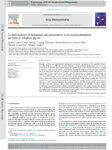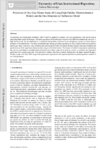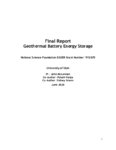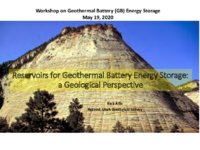|
|
Creator | Title | Description | Subject | Date |
| 1 |
 |
Ring, Terry Arthur | Growth kinetics of hexagonal sub-micrometric β-tricalcium phosphate particles in ethylene glycol | Recently, uniform, non-agglomerated, hexagonal b-tricalcium phosphate (b-TCP) platelets (diameter 400-1700 nm, h 100-200 nm) were obtained at fairly moderate temperatures (90-170 C) by precipitation in ethylene glycol. Unfortunately, the platelet aspect ratios (diameter/thickness) obtained in the ... | | 2014-01-01 |
| 2 |
 |
Ring, Terry Arthur | Verification of analytic energy moments for the one-dimensional energy dependent neutron diffusion equation with MCNP5 and Attila-7.1.0 | The energy dependent neutron diffusion equation (EDNDE) is converted into a moment equation which is solved analytically for the 1-D problem of a bare sphere of pure 235U. The normalized moments 0-5 generated analytically are compared to normalized energy moments, from Monte Carlo N Particle 5 versi... | | 2012-01-01 |
| 3 |
 |
Ring, Terry Arthur | Validation of energy moments from the one-dimensional energy dependent neutron diffusion equation, MCNP5 and Attila-7.1.0 with the GODIVA experiment | Normalized neutron energy moments (moments) from the one-dimensional energy dependent neutron diffusion equation (EDNDE), Monte Carlo N Particle 5 version 1.40 (MCNP5) and Attila-7.1.0-beta version (Attila) are validated with the GODIVA experiment (GODIVA). Energy moments 0-5 for all three methods a... | | 2012-01-01 |
| 4 |
 |
Sutherland, James Clayton | Prediction of oxy-coal flame stand-off using high-fidelity thermochemical models and the one-dimensional turbulence model | An Eulerian one-dimensional turbulence (ODT) model is applied to simulate oxy-coal combustion, with specific aim at predicting flame stand-o distances. Detailed gas-phase chemical kinetics based on the GRI3.0 mechanism are utilized. A high-fidelity model for devolatilization is considered that predi... | | 2014-01-01 |
| 5 |
 |
Stringfellow, Gerald B.; Shurtleff, James Kevin | Heterostructures in GaInP grown using a change in Te doping | In organometallic vapor phase epitaxy, changes in growth conditions can be used to modulate the extent of CuPt ordering and, hence, the band gap energy of GaInP. One method is to add Te during growth. An increase in the band gap energy of 0.1 eV due to a decrease in ordering has been obtained by ... | Heterostructures; Alloys | 2000 |
| 6 |
 |
Pershing, David W. | Design and construction of a rotary kiln simulator for use in studying the incineration of hazardous waste | Rotary kilns have been used extensively in the cement industry to calcine limestone. In the past few years, the technology has been viewed as a possible option for the incineration of hazardous waste materials, especially for the disposal of solid wastes and the cleanup of contaminated soils and tra... | Rotary kilns; Hazardous waste; Waste burning | 1989-08 |
| 7 |
 |
Sarofim, Adel F. | Simulation of soot formation using particle dynamics with one dimensional nucleation mode | Two soot formation models using particle dynamics with one-dimensional nucleation mode directly coupled with gas phase chemistry are tested on three ethylene and three methane laminar premixed flames. These models demonstrate strength in the prediction of concentration profiles of major combustion p... | Soot formation models; Particle dynamics; One dimensional nucleation mode; Combustion chemistry | 2004 |
| 8 |
 |
Eddings, Eric G.; Sarofim, Adel F. | Experimental study of burning rate in jet-fuel pool fires | Experiments were carried out in a 30 cm diameter pool fire, for both transient and steady-state conditions, utilizing jet fuel, Norpar-15, and a surrogate mixture of hydrocarbons that simulates jet-fuel behavior in a pool fire. Steady state pool fire tests match previous results well. The transient ... | Pool fires; Jet propulsion fuel; Norpar-15 | 2004 |
| 9 |
 |
Pershing, David W. | Mechanisms of NOx formation and control: alternative and petroleum-derived liquid fuels | Petroleum-, coal- and shale-derived liquid fuels were burned in a downfired tunnel furnace to assess the impact of fuel properties on the formation and control of NOx emissions. A nitrogen-free oxidant mixture (Ar, C02 , 02) was used to isolate fuel NOx formation. Under excess air conditions fuel N... | Exhaust emissions; Alternative fuels; Petroleum-derived liquid fuels | 1981 |
| 10 |
 |
Eddings, Eric G.; Spinti, Jennifer C.; Smith, Philip J. | Soot volume fraction from extinction in JP-8 and heptane pool fires | Total extinction measurements from a multiple beam experiment using a 10mW laser diode are presented and compared to calculate soot volume fraction in heavily sooting pool fires from a 150 mm diameter pan of Jet Propulsion fuel 8 (JP-8) and heptane. Trends in attenuation are critiqued for the t... | Pool fires; Jet propulsion fuel | 2005 |
| 11 |
 |
McLennan, John | Final Report Geothermal Battery Energy Storage | Solar and wind power are being introduced into electric grids to supplement and replace conventional electricity production. The deployment of utility-scale storage has not kept pace to overcome the intermittent nature of solar and to a lesser extent wind. Large-scale energy storage is cur... | | 2020-06 |
| 12 |
 |
Allis, Rick | Reservoirs for Geothermal Battery Energy Report: a geological perspective | Workshop presentation | | 2020-05-18 |
| 13 |
 |
Ring, Terry Arthur; Eddings, Eric G.; Sarofim, Adel F. | Determination of soot refractive index as a function of height in an inverse diffusion flame | With the scope of combustion diagnostics increasing, it is becoming ever more important for some of the more basic physical properties of soot to be addressed. Soot refractive index values were obtained as a function of height in a benzene inverse diffusion flame (IDF). The IDF was chosen for ease i... | Inverse diffusion flame | 2007 |
| 14 |
 |
Eddings, Eric G.; Smith, Philip J. | Soot volume fraction from extinction in JP-8 and heptane pool fires | Total extinction measurements from a multiple beam experiment using a 10mW laser diode are presented and compared to calculate soot volume fraction in heavily sooting pool fires from a 150 mm diameter pan of Jet Propulsion fuel 8 (JP-8) and heptane. Trends in attenuation are critiqued for the t... | Soot volume fraction; Heptane pool fires; JP-8 pool fires; Heavily sooting pool fires; Laser diagnostics | 2005 |
| 15 |
 |
Eddings, Eric G.; Sarofim, Adel F. | Fast cook-off tests report | The Center for the Simulation of Accidental Fires and Explosions (C-SAFE) at the University of Utah is focused on providing science-based tools for the numerical simulation of accident scenarios involving fires and high-energy devices (Pershing, 2000). The initial computational efforts are concentra... | Heat flux; Heat transfer; Cookoff tests; Center for the Simulation of Accidental Fires and Explosions; C-SAFE | 2003 |
| 16 |
 |
Sutherland, James Clayton; Kerstein, Alan R.; Chen, Jaqueline H. | An evaluation of the one-dimensional turbulence model: comparison with direct numerical simulation of CO/H2 jets with extinction and reignition | Abstract A variant of the One-Dimensional Turbulence (ODT) model formulated in an Eulerian reference frame is applied to a planar nonpre mixed turbulent jet flame and results from the model prediction are compared with DNS data. The model employed herein solves the full set of conservation equation... | | 2010 |
| 17 |
 |
Eddings, Eric G.; Sarofim, Adel F.; Pugmire, Ronald J. | Selection of surrogates for jet fuels | Abstract: A. detailed characterisation of JP fuels is provided based on literature data for the average of 55 worldwide and 4 US Jet-A fuels. These are complemented by NMR analysis of a JP-8 that provides the fractions of the carbon in the fuel that are present as protonated, bridgehead, and non-sub... | Jet propulsion fuel; Surrogates; Simulations | 2008 |
| 18 |
 |
Lighty, Joann; Sarofim, Adel F. | Carbon dioxide effects on metal vaporization during coal combustion | Coal combustion products may take one of two forms. Residual ash (> 1 micron) is formed by particle shrinkage and breaking during combustion. Some material will vaporize and later recondense. During recondensation, these molecules have a high affinity for submicron particles because of the large sur... | Coal combustion products; Metal vaporization; Carbon dioxide; Residual ash | 2001 |
| 19 |
 |
Pershing, David W.; Wendt, Jost O. L. | Pulverized coal combustion: NOx formation mechanisms under fuel rich and staged combustion conditions | A 2 Kg/h pulverized fuel one dimensional flame combustor was used to determine time resolved NO profiles under fuel rich and staged combustion conditions. Seven solid fuels, including two coal chars, were investigated. Results show that at all fuel rich conditions NO is formed rapidly and then is ... | Flame; Composition; Reaction | 1979 |
| 20 |
 |
McLennan, John | Large-scale subsurface seasonal heat storage for future value | I too extend my welcome. And, I extend thanks to the NSF for the support of this research at the Univ. of Utah. The concept of storing heat in the ground is certainly not new. Many, many cases have investigated heat to be stored underground. Getting the heat underground is somewhat of a problem, but... | | 2020-05-19 |
| 21 |
 |
McLennan, John | Geothermal Battery Surface Facilities Economics and Finance as an O&G play | | | |
| 22 |
 |
Veranth, John M.; Pershing, David W.; Sarofim, Adel F. | Sources of unburned carbon in the fly ash produced from low-NOx pulverized coal combustion | The unburned carbon in the fly ash produced from low-NOx pulverized coal combustion is shown to consist of a mixture of soot and coal char. The soot was identified by the presence of chains or aggregates of 10-50-nm-diameter primary particles in electron microscope images of both laboratory sample... | Unburned carbon; Char | 1998 |
| 23 |
 |
Pershing, David W. | Bench and pilot scale process evaluation of reburning for in-furnace NOx reduction | This paper describes a combined experimental and theoretical study which was undertaken to quantify the impact of fuel and process parameters on reburning effectiveness and provide the scaling information required for commercial application of reburning under highly varied industrial conditions. Ini... | Reburning; Nitrogen oxides reduction; Staged fuel injection | 1986 |
| 24 |
 |
Sarofim, Adel F. | Numerical combustion of aviation fuel part I: a cross-model comparison of n-heptane premixed flame | Four different n-heptane mechanisms were used to simulate a fuel rich n-heptane premixed flame and their results were compared with experimental measurements. In addition to discussion of the numerical performance of each mechanism, flux analysis coupled with the atomic distribution technique was us... | Aviation fuel; n-heptane; Premixed flame | 2003 |
| 25 |
 |
Pershing, David W. | Biomass combustion: relationship between pollutant formation and fuel composition | A 65-kW refractory-walled reactor was used to study biomass combustion under conditions typical of the suspension-burning phase in a spreader-stoker-fired boiler. Isothermal combustion data and nitric oxide (NO) emission rates were obtained as a function of temperature, local oxygen concentration, ... | Combustion; Emissions; Energy; Environmental control; Fuels; Pyrolysis; Biomass fuel; Particulates | 1989 |

























